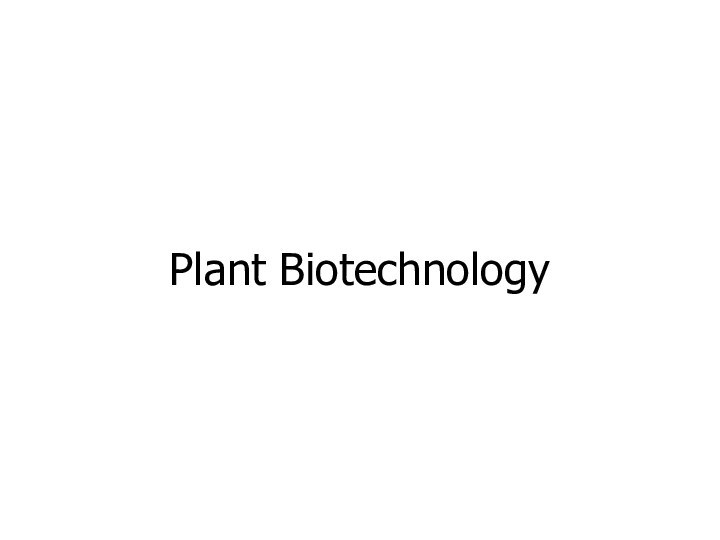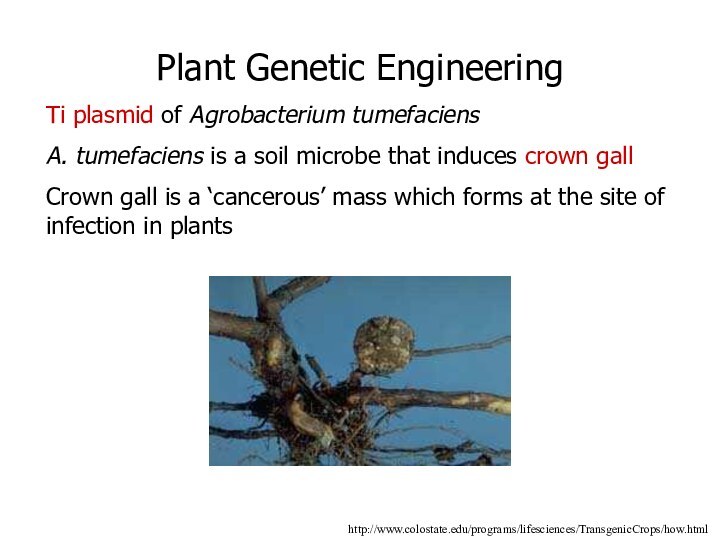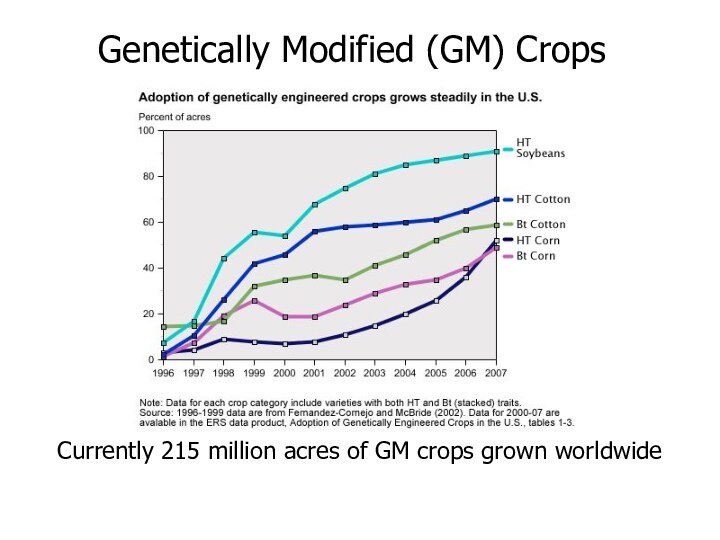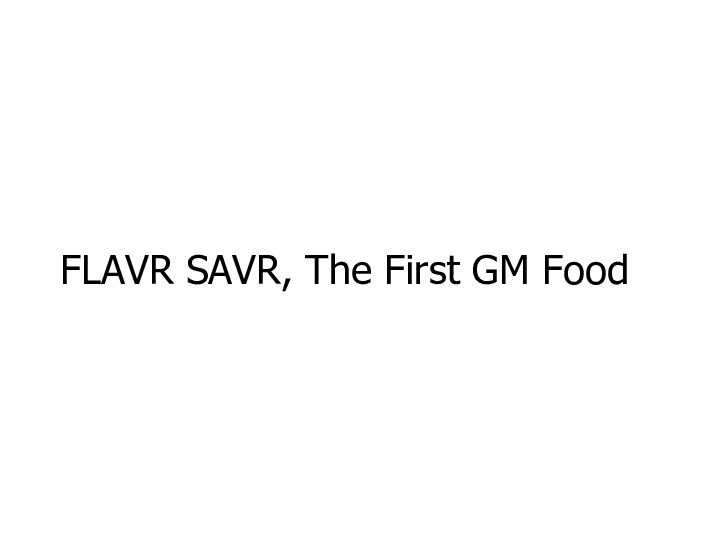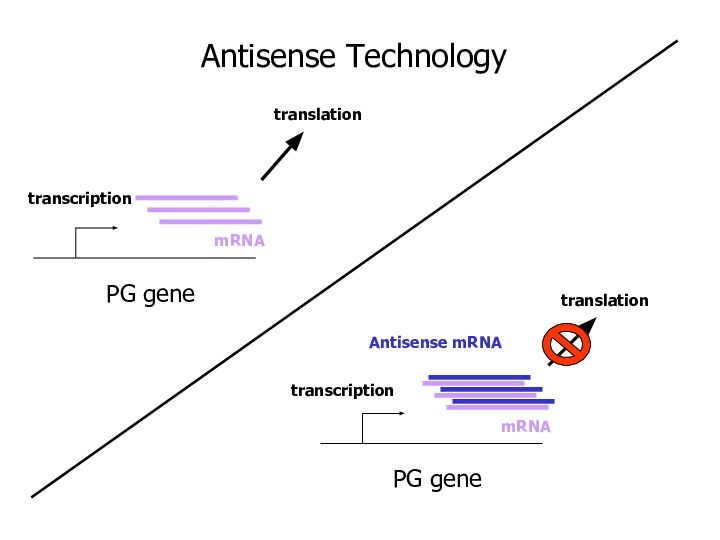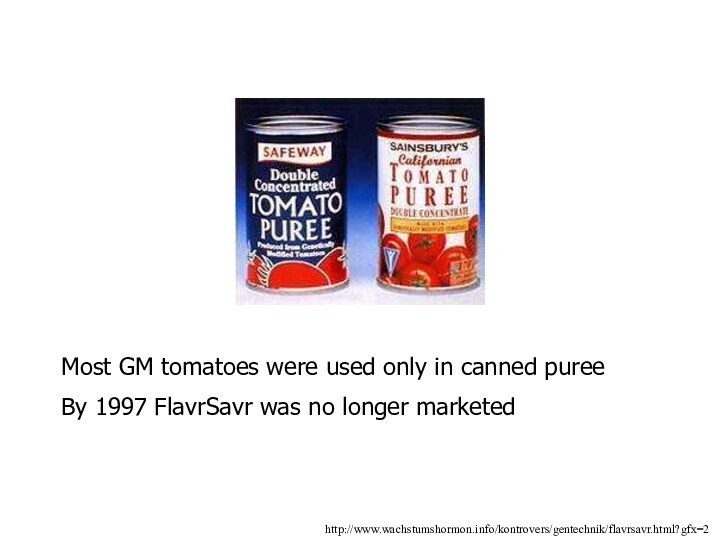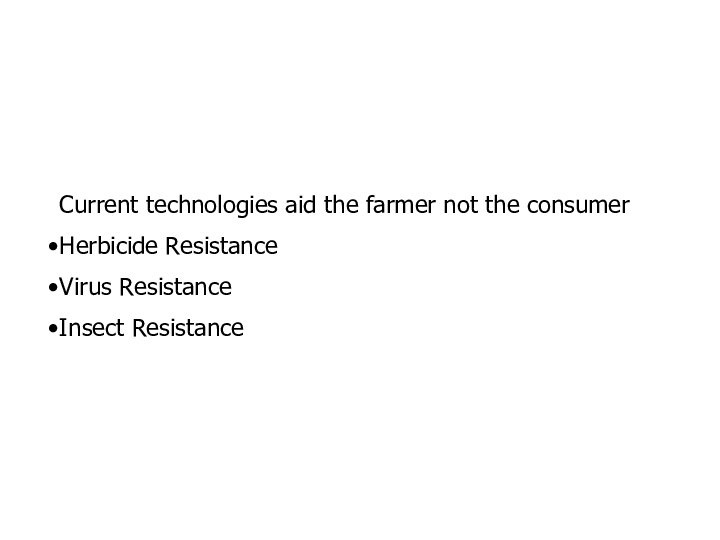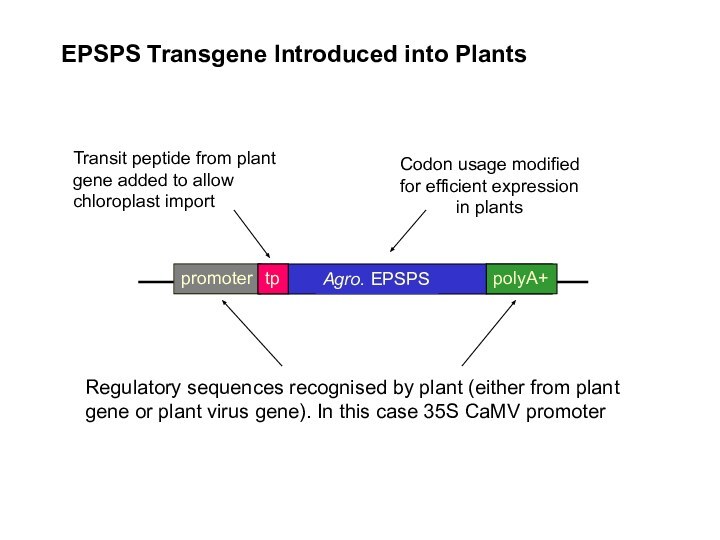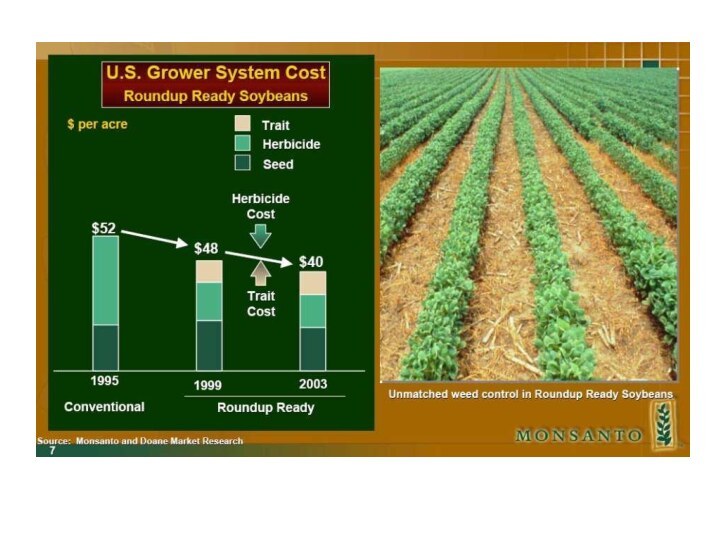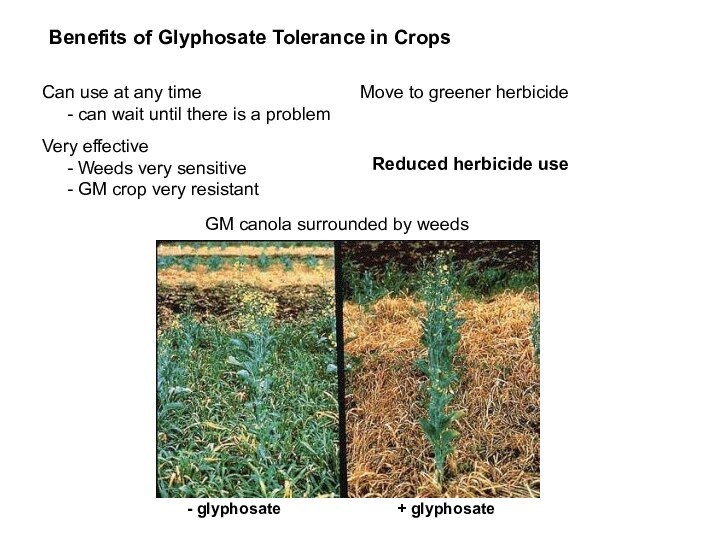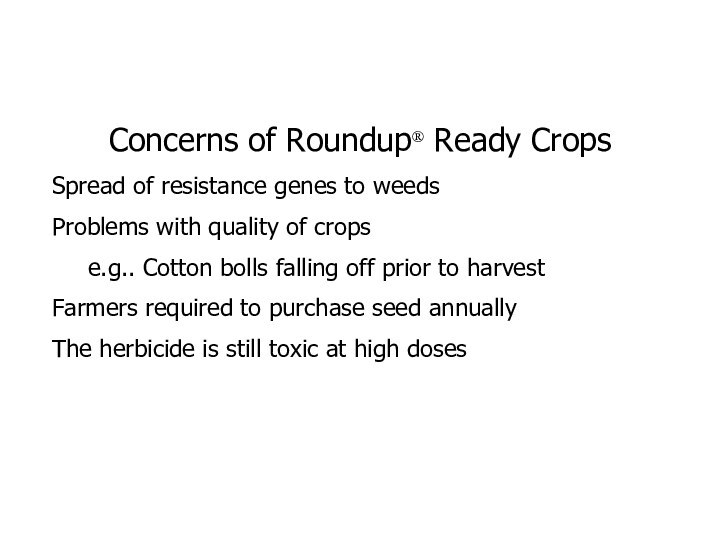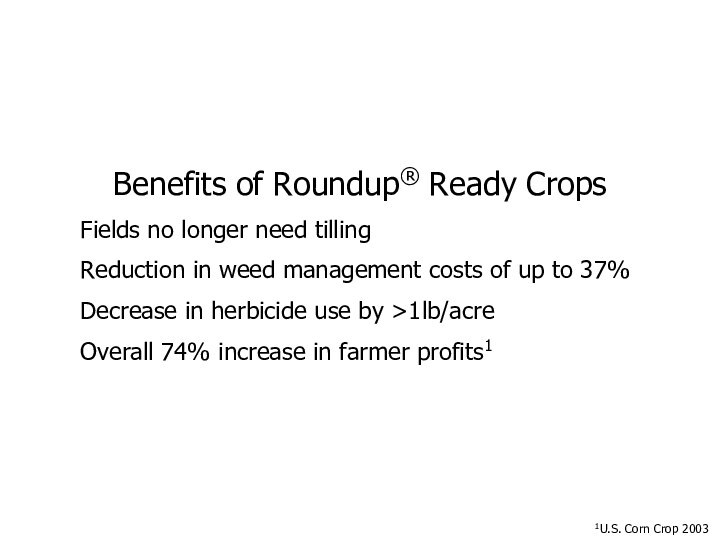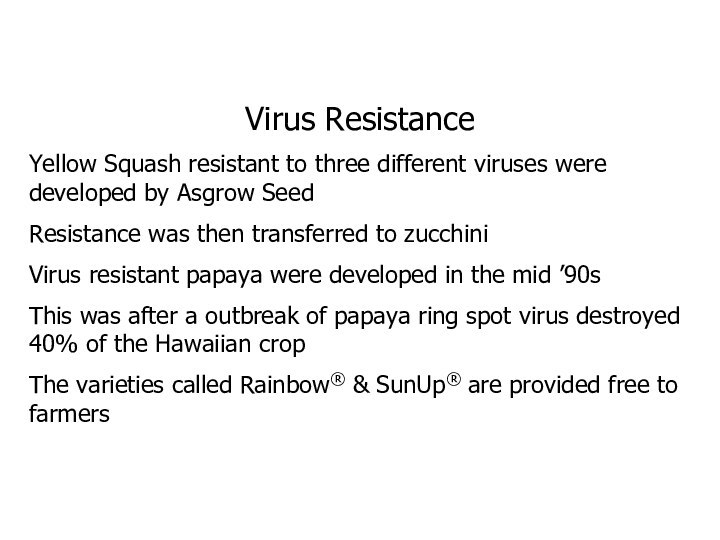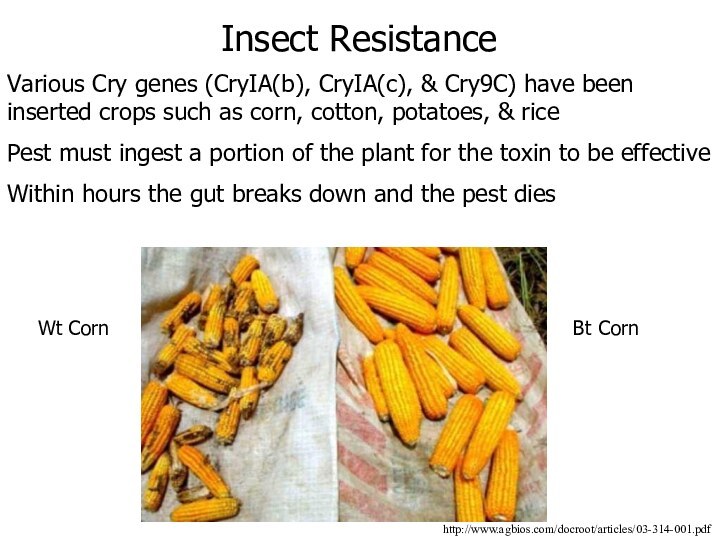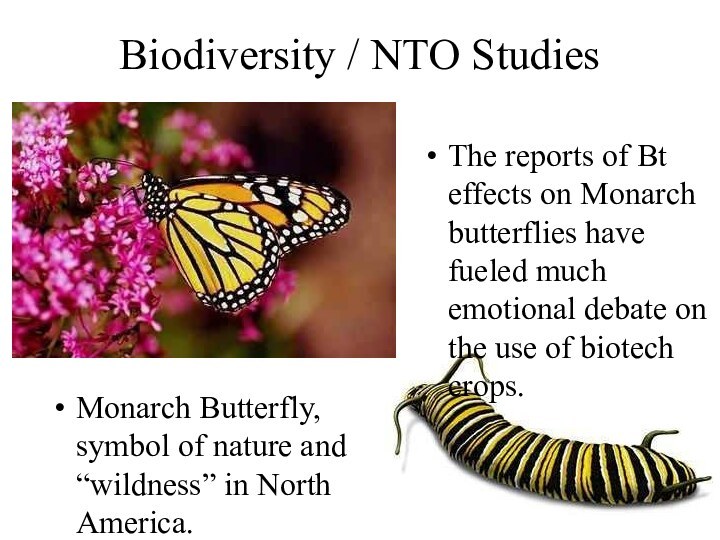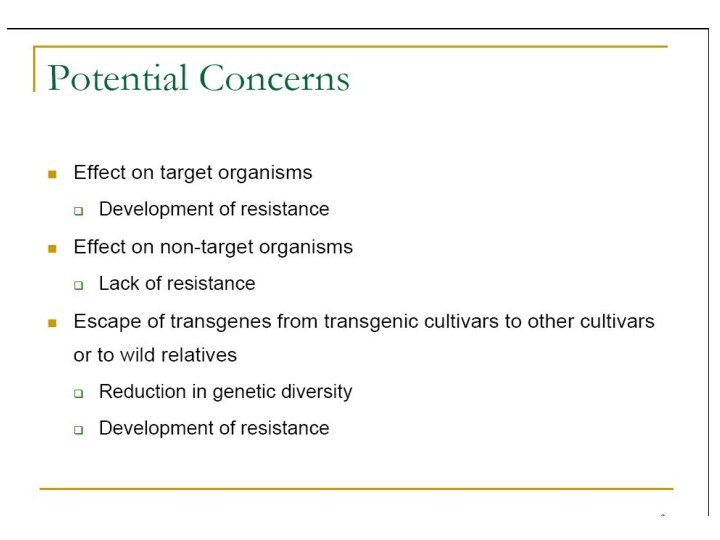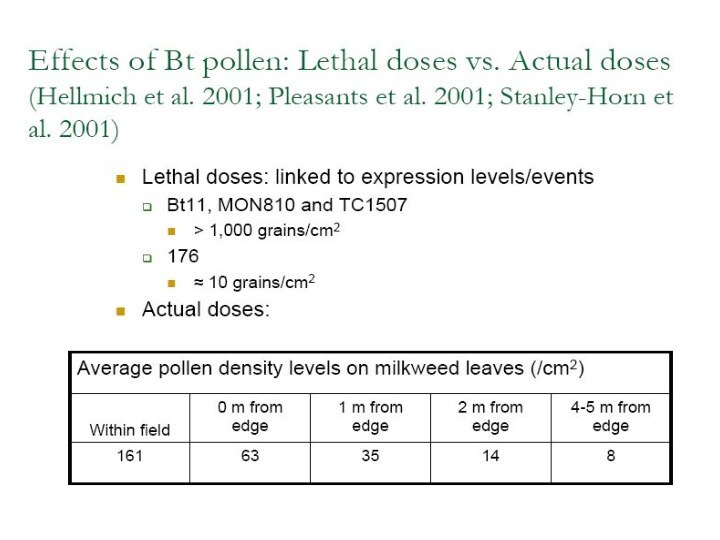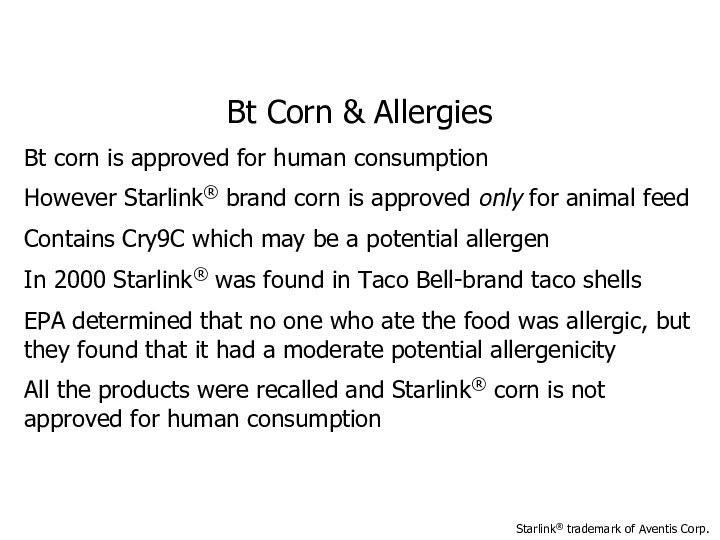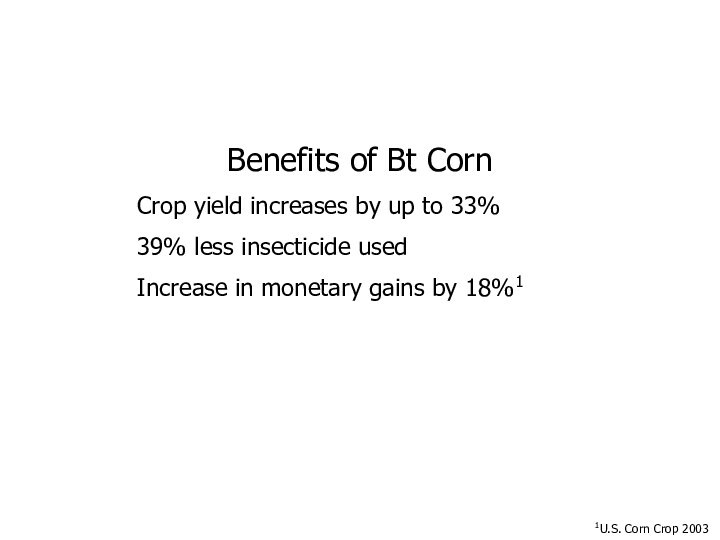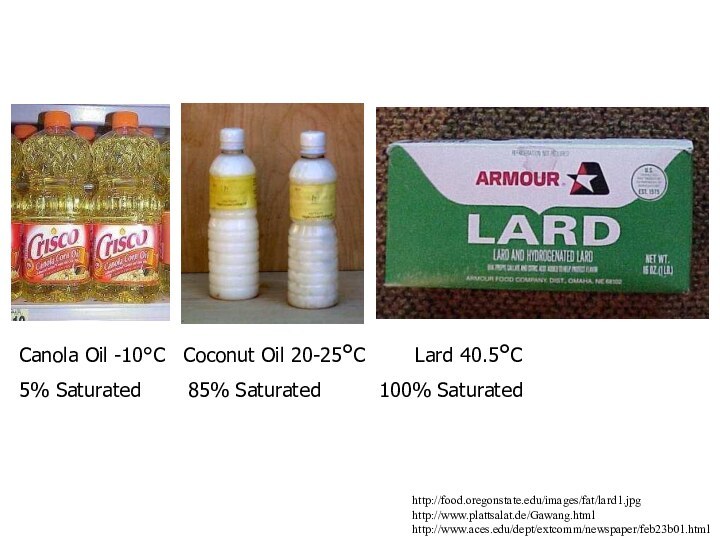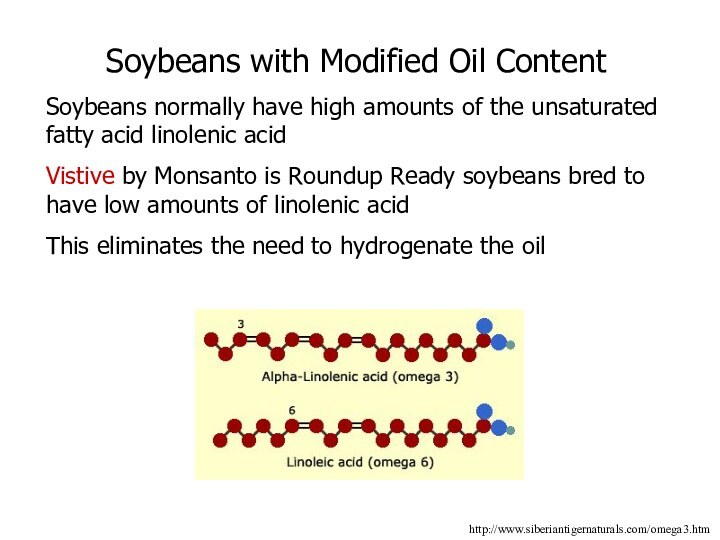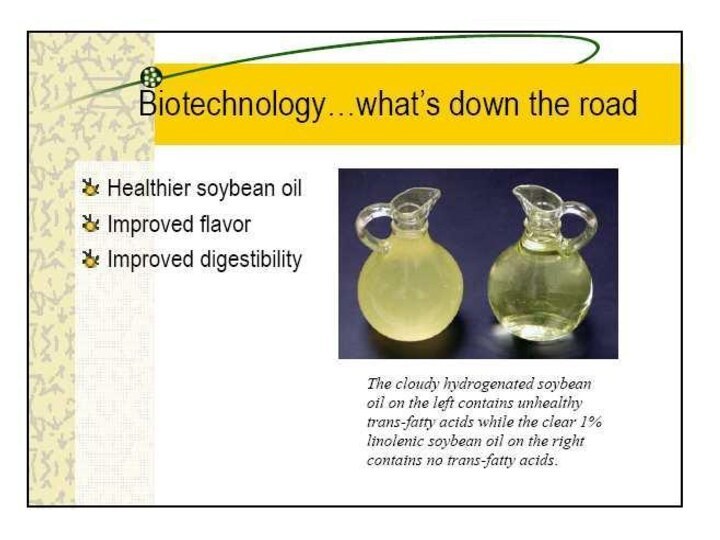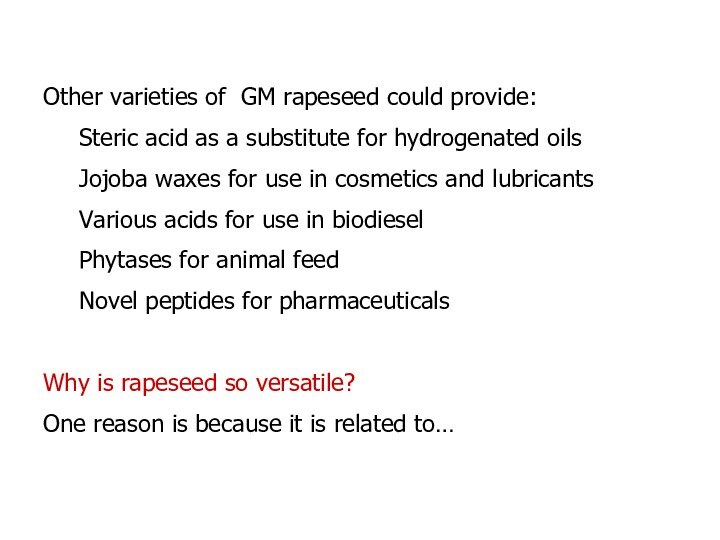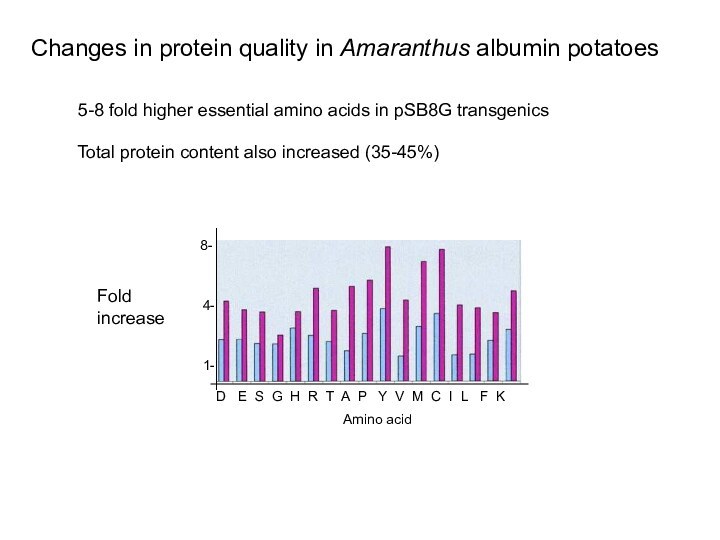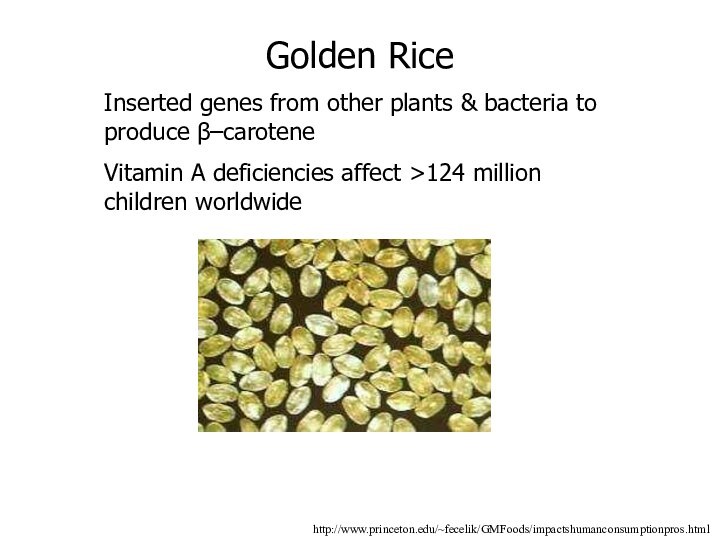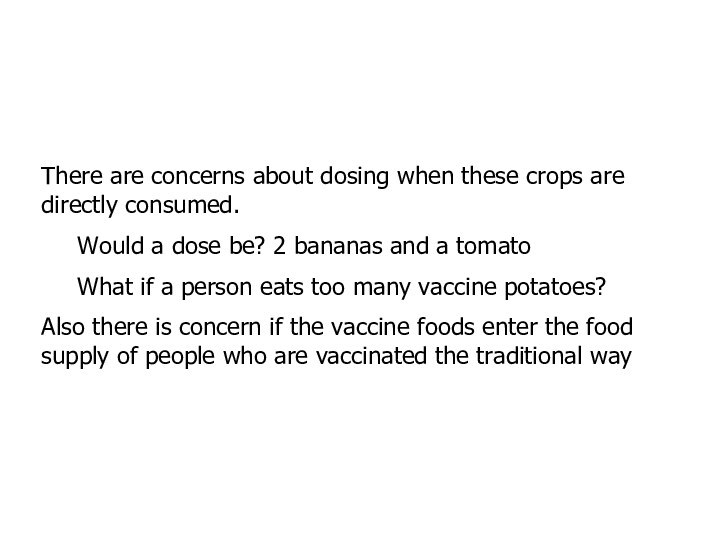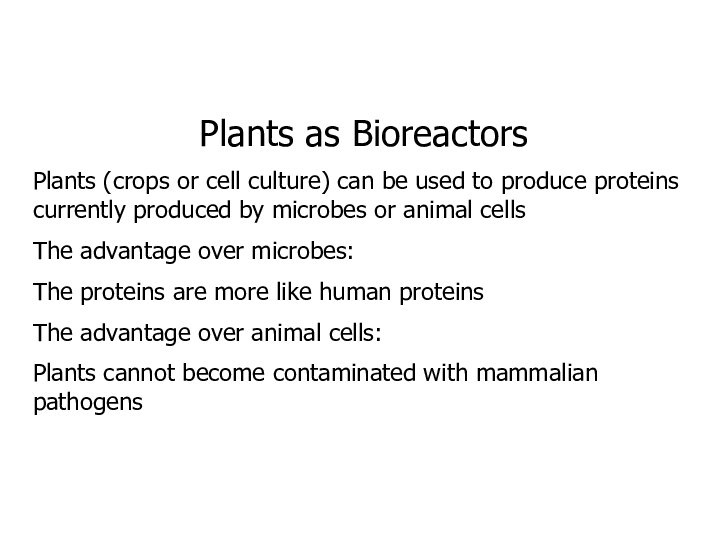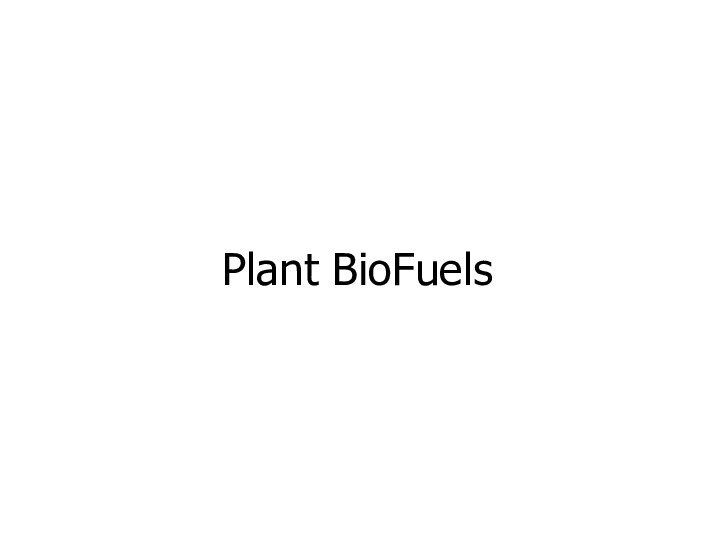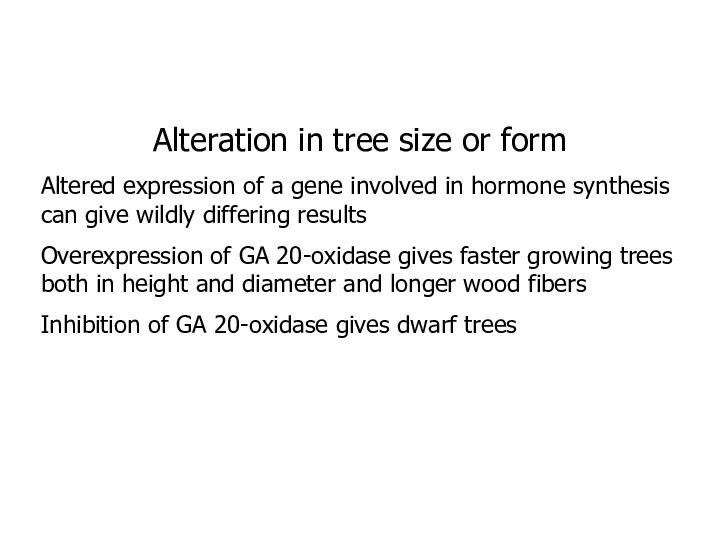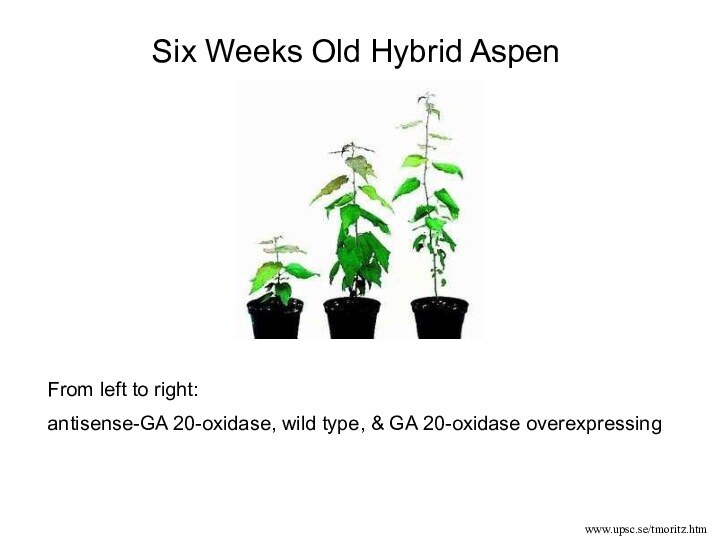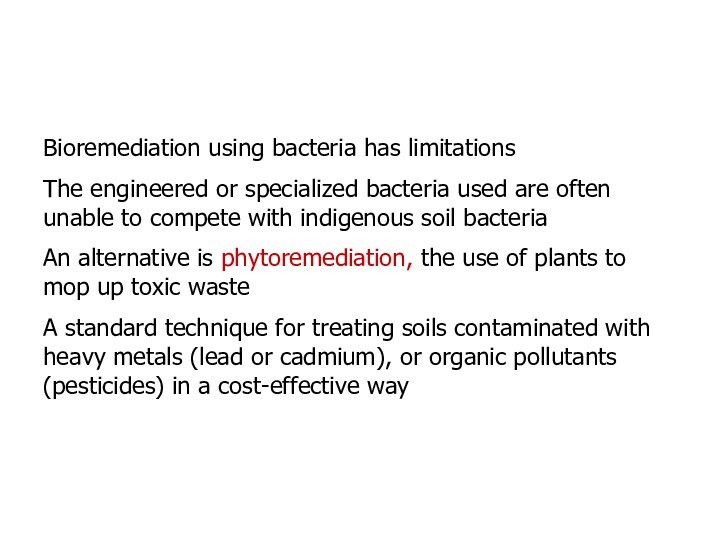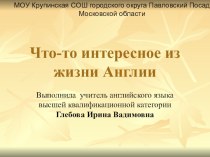Слайд 2
Plant Tissue Culture
Plant cells differ from animals cells
in that they are totipotent
A totipotent cell is one
that can develop into specialized cell types & regenerate an entire organism
Tissue culture of plants and the regeneration of complete plants from cells has been done since 1930s
This allows large-scale clonal propagation of plants
Слайд 3
http://www.webschoolsolutions.com/biotech/transgen.htm
Plant Cloning
Слайд 4
http://catf.bcresearch.com/biotechnology/tissueculture_research.htm
Micropropagation
Callus, undifferentiated mass of plant cells
Seedlings, each from
an individual cell
Слайд 5
How Do They Engineer Plants?
Слайд 6
Methods of producing transgenic plants
Слайд 7
http://www.colostate.edu/programs/lifesciences/TransgenicCrops/how.html
Plant Genetic Engineering
Ti plasmid of Agrobacterium tumefaciens
A. tumefaciens
is a soil microbe that induces crown gall
Crown gall
is a ‘cancerous’ mass which forms at the site of infection in plants
Слайд 8
T-DNA portion of the Ti plasmid contains genes
responsible for the disease
T-DNA becomes incorporated into the genome
of the plant
Part of the T-DNA may be replaced with a foreign gene and used to incorporate this gene into the plant’s genome
A marker is also added to determine which cells have the recombinant gene
TIBS 1998, 19:500-506.
Слайд 9
http://www.webschoolsolutions.com/biotech/transgen.htm
Слайд 10
http://faculty.abe.ufl.edu/~chyn/age2062/lect/lect_09/10_19A.GIF
Biolistics (Biological Ballistics)
Useful for engineering corn, rice, wheat,
barley, & other crops
Слайд 11
Helios Gene Gun
http://www.bio-rad.com
Uses an adjustable burst low-pressure helium
to sweep DNA- or RNA-coated gold pellets from the
inner wall of a small plastic cartridge directly onto a target
Слайд 12
Genetically Engineered Plants
Herbicide tolerance
Insect resistance
Crop improvements
Functional foods
Plants as
bioreactors
Biofuels
Timber improvements
Bioremediation
Слайд 13
Currently 215 million acres of GM crops grown
worldwide
Genetically Modified (GM) Crops
Слайд 14
>60% of the foods we purchase have GM
ingredients
95% of canola is biotech herbicide-tolerant
50% of corn
is biotech herbicide-tolerant
35% of corn is biotech insect-resistant
61% of cotton is biotech herbicide-tolerant
52% of cotton is biotech insect-resistant
93% of soybean is biotech herbicide-tolerant
(2005 Data, Source :GM Crops: The First 10 Years -- Global Socio-economic and Environmental Impacts; PG Economics Limited )
How Much of What We Eat Is GM?
Слайд 15
Who Produces GM Food?
BASF Inc.
Aventis Cropscience
Bayer Cropscience
Syngenta Seed
Inc.
Pioneer Hi-Breed International Inc.
Dow Agroscience LLC
Monsanto Company
Слайд 17
http://resources.emb.gov.hk/envir-ed/globalissue/images/ModifiedTomato.jpg
The first GM food was the FLAVR SAVR
tomato
Introduced in 1994 it had delayed ripening characteristics
Слайд 18
Fruit softens because polygalacturonase degrades pectin
Antisense technology was
used to turn off (silence) the polygalacturonase (PG) gene
Gene
encoding antisense RNA was inserted into tomato cells
The antisense RNA finds the normal RNA and hybridizes
The cell then degrades this complex, preventing the normal RNA from being translated
Слайд 19
PG gene
transcription
mRNA
translation
PG gene
transcription
mRNA
Antisense mRNA
translation
Antisense Technology
Слайд 20
Polygalacturonase (PG) is an enzyme that breaks
down pectin in ripening fruit walls
Plants with an
antisense PG
transgene produce less PG.
Walls soften more slowly
Many genes manipulated in the
same way to answer basic
questions:
- what is the role of hormones
in ripening?
- what do particular enzymes do in
fruit walls?
Wild-type
fruit
Antisense PG
fruit
PG activity
Days from 1st colour change
0
10
2
4
6
8
Altering Fruit Ripening with Antisense RNA
Слайд 21
http://www.wachstumshormon.info/kontrovers/gentechnik/flavrsavr.html?gfx=2
Most GM tomatoes were used only in canned
puree
By 1997 FlavrSavr was no longer marketed
Слайд 22
Current technologies aid the farmer not the consumer
Herbicide
Resistance
Virus Resistance
Insect Resistance
Слайд 23
Herbicide Tolerance
Methods used to promote crop growth also
promote weeds
Weeds often outgrow crops and reduce farm output
Even
though there are about 100 chemical herbicides, weeds still reduce crop productivity by ~12%
Problem is that many herbicides kill both crops & weeds
This has led to the creation of herbicide tolerant crops
Слайд 24
Soybean with no herbicides
Soybean after herbicides
Herbicides are used
for weed control
Herbicide Tolerance
Weeds
drastically
reduce
crop
yield
and quality
Слайд 26
Non-selective herbicides
(Roundup Ultra and)
Roundup® (chemical name:
glyphosate)
Breaks down quickly in the soil,
eliminating
residual
carry-over problems
and
reducing environmental impact.
Roundup Ready®
transgenic varieties
of common crops
completely resistant
to those herbicides
Слайд 28
EPSPS Transgene Introduced into Plants
Codon usage modified
for efficient
expression
in plants
promoter
Regulatory sequences recognised by plant (either from
plant gene or plant virus gene). In this case 35S CaMV promoter
Agro. EPSPS
Transit peptide from plant gene added to allow chloroplast import
Слайд 30
Move to greener herbicide
Benefits of Glyphosate
Tolerance in Crops
Can use at any time
- can wait until there is a problem
Reduced herbicide use
Very effective
- Weeds very sensitive
- GM crop very resistant
GM canola surrounded by weeds
- glyphosate
+ glyphosate
Слайд 31
Roundup® Ready Crops
Corn
Alfalfa
Soybeans
Canola
Sorghum
Cotton
Tomato
Potato
Wheat
Слайд 32
1996 Roundup® Ready Gene Agreement
Terms:
The farmer
must pay a $5 per bag "technology fee“
The
farmer must give Monsanto the right to inspect, monitor and test his/her fields for up to 3 years
The farmer must use only Monsanto's brand of the glyphosate herbicide it calls Roundup®
Слайд 33
The farmer must give up his/her right
to save and replant the patented seed (replanting seed
is a practice as old as agriculture)
The farmer must agree not to sell or otherwise supply the seed to "any other person or entity."
The farmer must also agree, in writing, to pay Monsanto "...100 times the then applicable fee for the Roundup® Ready gene, times the number of units of transferred seed, plus reasonable attorney's fees and expenses..." should he violate any portion of the agreement.
Слайд 34
Concerns of Roundup® Ready Crops
Spread of resistance genes
to weeds
Problems with quality of crops
e.g.. Cotton bolls falling
off prior to harvest
Farmers required to purchase seed annually
The herbicide is still toxic at high doses
Слайд 35
Benefits of Roundup® Ready Crops
Fields no longer need
tilling
Reduction in weed management costs of up to 37%
Decrease
in herbicide use by >1lb/acre
Overall 74% increase in farmer profits1
1U.S. Corn Crop 2003
Слайд 36
Roundup® patent recently expired
Researchers have designed new method
of resistance
Sorted thru 100s of microbes to find a
detoxifying enzyme
Found 3 genes in Bacillus licheniformis which encode glyphosate N-acetyltransferase (GAT)
Using directed evolution generated an enzyme 10000x more efficient
~5yrs to market
Слайд 37
There are also varieties of various crops resistant
to:
Glufosinate
Bromoxyil
Sulfonylurea
Слайд 38
Virus Resistance
Yellow Squash resistant to three different viruses
were developed by Asgrow Seed
Resistance was then transferred to
zucchini
Virus resistant papaya were developed in the mid ’90s
This was after a outbreak of papaya ring spot virus destroyed 40% of the Hawaiian crop
The varieties called Rainbow® & SunUp® are provided free to farmers
Слайд 39
Transgenic PRV-resistant papaya has been grown commercially in
Hawaii since 1996
Increased virus resistance: Papaya ringspot virus (PRV)
Virus
has had huge impact on papaya industry in Hawaii - reduction of fresh fruit production directly related to spread of PRV
No naturally occurring resistance genes - without GM, papaya industry in Hawaii would be destroyed
Слайд 40
promoter
Regulatory sequences recognised by plant
(either from plant gene
or plant virus gene).
In this case 35S CaMV promoter
and terminator
polyA+
PRV coat protein gene expressed from 35S CaMV promoter.
Papaya transformed by particle bombardment
PRV coat protein gene
Confers partial resistance to PRV in one variety (‘Rainbow’) and complete resistance in another (‘SunUp’)
Growers have to sign up to careful crop management - minimize virus pressure on transgenics to maintain resistance
Papaya Resistant to PRV
Слайд 41
Various Cry genes (CryIA(b), CryIA(c), & Cry9C) have
been inserted crops such as corn, cotton, potatoes, &
rice
Pest must ingest a portion of the plant for the toxin to be effective
Within hours the gut breaks down and the pest dies
Insect Resistance
http://www.agbios.com/docroot/articles/03-314-001.pdf
Wt Corn
Bt Corn
Слайд 42
What is BT
doplnit z prednasky roslinna biotechnologie
Слайд 43
Molecular basis of the Bt action
Слайд 44
Bt Corn & Monarch Butterflies
Cry toxin is expressed
in all of the plant as well as pollen
Corn
pollen can blow onto milkweed growing near corn fields
Monarch caterpillars feed exclusively on milkweed
An early study showed a possible toxic effect of Bt pollen on monarch caterpillars
http://homepages.ihug.co.nz/~mostert/land%20photography/Insects/insects/monarch%20butterfly.jpg
Слайд 45
Biodiversity / NTO Studies
Monarch Butterfly, symbol of nature
and “wildness” in North America.
The reports of Bt effects
on Monarch butterflies have fueled much emotional debate on the use of biotech crops.
Слайд 51
Bt Corn & Allergies
Bt corn is approved for
human consumption
However Starlink® brand corn is approved only for
animal feed
Contains Cry9C which may be a potential allergen
In 2000 Starlink® was found in Taco Bell-brand taco shells
EPA determined that no one who ate the food was allergic, but they found that it had a moderate potential allergenicity
All the products were recalled and Starlink® corn is not approved for human consumption
Starlink® trademark of Aventis Corp.
Слайд 52
Benefits of Bt Corn
Crop yield increases by up
to 33%
39% less insecticide used
Increase in monetary gains by
18%1
1U.S. Corn Crop 2003
Слайд 53
Concerns associated with GM crops
Possible production of allergenic
or toxic proteins
not native to the crop
2.
Adverse effects on non-target organisms,
especially pollinators and biological control organisms
3. Loss of biodiversity
4. Genetic pollution (unwanted transfer of genes to other species)
5. Development of pest resistance
6. Global concentration of economic power and food production
7. Lack of "right-to-know"
(i.e., a desire for labeling transgenic foods)
Слайд 54
How to prevent development of Bt resistance in
insects?
at least 20%
of a farm's corn acreage
must be planted
to non-BT corn.
R = resistant European borer;
S = susceptible borer.
few Bt-resistant insects
surviving in the Bt field
would likely mate
with susceptible individuals
that have matured
in the non-Bt refuge.
Thus, the resistance alleles
would be swamped
by the susceptible alleles.
< 80%
> 20%
Strategy will not work if resistance is dominant !!!
Слайд 56
Crop Improvements
Current research into crop improvements include:
Increased
growth rate
Increased salt tolerance
Increased drought resistance
Modification
of seed oil content
Слайд 57
Drought / Salinity Resistance
Trehalose is a protectant against
many environmental stresses; freezing, osmotic pressure (salinity), heat and
dessication.
Trehalose (1-α-D-glucopyranosyl-glucopyranoside)
is synthesised in a two-step process in yeast.
Zygosaccharomyces rouxii is one of the most highly
osmo-tolerant yeasts – especially to salt
Kwon, S.J., Hwang, E.W. & Kwon, H.B. (2004). Genetic
engineering of drought resistant potato plants by
co-introduction of genes encoding trehalose-6-phosphate
synthase and trehalose-6-phosphate phosphatase of
Zygosaccharomyces rouxii. Korean J. Genet. 26, 199-206.
Transgenic potatoes morphologically identical to parents.
trehalose-6-P synthase
trehalose-6-P phosphotase
2A
RB
LB
CaMV
35S
nptII
NS ter
NS prom
Слайд 58
Modification of Seed Oil Content
Слайд 59
Plant Seed Oils
Oils either for cooking or industrial
uses are usually extracted from seeds such as,
Corn, safflower,
sunflower, canola, coconut, flax
Seed rely on their stored oil as an energy & carbon sources for germination
Most seed oils are made up of unsaturated fatty acids
Some tropical oils such as palm & coconut have significant levels of saturated fatty acids
Слайд 60
http://biology.clc.uc.edu/courses/bio104/lipids.htm
Fatty Acids
Triglyceride
Слайд 61
http://food.oregonstate.edu/images/fat/lard1.jpg
http://www.plattsalat.de/Gawang.html
http://www.aces.edu/dept/extcomm/newspaper/feb23b01.html
Canola Oil -10°C Coconut Oil 20-25°C Lard 40.5°C
5%
Saturated 85% Saturated 100% Saturated
Слайд 62
http://biology.clc.uc.edu/courses/bio104/lipids.htm
Cis-fatty acids, naturally occuring unsaturated acids
Trans-fatty acids, artifically
generated to keep unsaturated fatty acids from going rancid
Trans-fatty
acids increase LDL (bad cholesterol) increasing the risk of heart disease
Слайд 63
Soybeans with Modified Oil Content
Soybeans normally have high
amounts of the unsaturated fatty acid linolenic acid
Vistive by
Monsanto is Roundup Ready soybeans bred to have low amounts of linolenic acid
This eliminates the need to hydrogenate the oil
http://www.siberiantigernaturals.com/omega3.htm
Слайд 66
Over 60 million tons of seed oil are
used for edible purposes
About 15 million tons is employed
in industrial usage
One of the first plants modified was Rape (Brassica napus oleifera)
A member of the mustard family, Rape has been grown for centuries as animal feed and natural lubricant
In the 1970s selective breeding led to strains of Rape lacking erucic acid
The removal of erucic acid made the oil fit for human consumption, LEAR (low-erucic acid rapeseed)
Слайд 67
Rape field full of brillantly yellow flowers
http://www.tiscali.co.uk/reference/encyclopaedia/hutchinson/m0011652.html
Слайд 68
The first transgenic crop with modified oil content
was a high lauric oil rapeseed.
Rapeseed oil normally contains
about 0.1% lauric acid
Modified rapeseed contains ~40% lauric acid
Lauric acid from GM rapeseed would be used in place of oils from palm or coconut
The primary use of lauric acid is in detergents
CH2-CH2-CH2-CH2-CH2-CH2-CH2-CH2-CH2-CH2-CH2-CH2-SO4- Na+
Sodium Lauryl Sulfate a.k.a SDS
Слайд 69
Other varieties of GM rapeseed could provide:
Steric acid
as a substitute for hydrogenated oils
Jojoba waxes for use
in cosmetics and lubricants
Various acids for use in biodiesel
Phytases for animal feed
Novel peptides for pharmaceuticals
Why is rapeseed so versatile?
One reason is because it is related to…
Слайд 70
http://www.teedrogen.info/systematik/7_bilder/ara-th-1.jpg
Arabidopsis thaliana (Cress)
Arabidopsis is a model organism used
by scientists to investigate plant development and genomics
The Arabidopsis
genome was recently completed
Слайд 71
http://www.thegutsygourmet.net/post-brassica.jpg
Brassica (Mustard) Family
Слайд 73
Improving Protein Quality
Nutritional value of
seed storage proteins is often limited
- may lack one
or more amino acid essential to human health
e.g. legume seeds lack cysteine and methionine; other seeds can lack lysine
Animals and humans are incapable of making 10 ‘essential’ amino acids
- must obtain in diet
Amino acid balance in seeds has been manipulated in laboratory experiments using a number of strategies:
- introduce seed storage protein from another species
- alter sequence of seed storage protein gene in vitro
- manipulate amino acid biosynthetic pathway to increase abundance of particular amino acids
Similar strategies have been used to improve protein content and composition in non-seed food crops...
Слайд 74
‘Increased nutritive value of transgenic potato by expressing
a nonallergenic seed albumin gene from Amaranthus hypochondriacus’
Chakraborty et
al., PNAS 97, 3724-3729 (2000)
Potato is the fourth most abundant global crop and used for food, animal feed and production of starch and alcohol
Limited in lysine, tyrosine, methionine and cysteine
Transformed potato with seed albumin from Amaranthus hypochondriacus which has good amino acid balance
p35S CaMV
Nos 3’
AmA1
pGBSS
Nos 3’
AmA1
2 alternative constructs. Promoters constitutive or tuber-specific
Expression in tuber 5-10 fold higher with GBSS promoter than with 35S promoter
pSB8
pSB8G
Слайд 75
Changes in protein quality in Amaranthus albumin potatoes
5-8 fold higher essential amino acids in pSB8G
transgenics
Total protein content also increased (35-45%)
Fold
increase
1-
8-
4-
D E S G H R T A P Y V M C I L F K
Amino acid
Слайд 76
http://www.princeton.edu/~fecelik/GMFoods/impactshumanconsumptionpros.html
Golden Rice
Inserted genes from other plants & bacteria
to produce β–carotene
Vitamin A deficiencies affect >124 million children
worldwide
Слайд 77
Vitamin A
Vitamin A (retinol) is essential to
human growth
Our bodies cannot make vitamin A,
All carotenoids
that contain a β-ring can be converted into retinol, and one of the most important carotenoid pro-vitamins is β-carotene
β-carotene is a pigment required for photosynthesis
- produced in all plant green tissues
Слайд 78
400 million people are at risk of vitamin
A deficiency (VAD), particularly in Asia and Africa
implicated in
up to 2.5 million deaths annually in children under 5
0.5 million children go blind each year
because of VAD
Supplementation programmes have reduced child mortality by up to 50% in target areas
supplementation not universal; expensive; misses remote areas
VAD makes children especially vulnerable to infections
Vitamin A deficiency
VAD is most serious in regions where rice is the staple food ; up to 70% children under 5 affected
Слайд 80
Vaccine Foods
In the early 1990’s tomatoes, bananas, &
potatoes were proposed as delivery vehicles for vaccines
Touted as
a simple method of delivering vaccines especially to developing countries
Studies have shown plant-produced oral vaccines to increase immunity in mice
Potatoes containing Hepatitis B vaccine have been shown to boost immunity in humans
Слайд 81
There are concerns about dosing when these crops
are directly consumed.
Would a dose be? 2 bananas
and a tomato
What if a person eats too many vaccine potatoes?
Also there is concern if the vaccine foods enter the food supply of people who are vaccinated the traditional way
Слайд 82
Plants as Bioreactors
Plants (crops or cell culture) can
be used to produce proteins currently produced by microbes
or animal cells
The advantage over microbes:
The proteins are more like human proteins
The advantage over animal cells:
Plants cannot become contaminated with mammalian pathogens
Слайд 83
Large Scale Biology Corp. (LSBC) uses tobacco plants
for drug manufacturing
LSBC uses an engineered tobacco mosaic virus
(TMV)
Recombinant gene is inserted into TMV which infects & replicates in the plants
During replication large amounts of the drug are generated
The drug accumulates in the leaves which are harvested
α-galactosidase A purified from tobacco is as effective in treating Fabry’s disease as the animal cell derived drug
Слайд 84
USDA just approved the use of rice to
produce lactoferrin and lysozyme
Sigma-Aldrich now sells aprotinin and typsin
made in tobacco
Duckweed is being used to produce interferon-α
More and More Plants Are Being Used to Produce Proteins
Слайд 86
Cellulosic Ethanol
Has higher yield due to the fermentation
of sugar released from cellulose
Requires the addition of cellulase
or acid
Agricultural plant wastes (corn stover, cereal straws)
Plant wastes from industrial processes (sawdust, paper pulp)
Crops grown specifically for fuel production (switchgrass)
Слайд 87
BioDiesel
1900 Rudolph Diesel runs his engine on peanut
oil
Biodiesel is defined as “a fuel comprised of mono-alkyl
esters of long chain fatty acids derived from vegetable oils or animal fats”
Transesterification converts triglycerides into methyl esters of fatty acids
http://www.campa-biodiesel.de/caengnof/caenkra2.htm
Слайд 88
http://www.biodiesel.org/pdf_files/fuelfactsheets/Production_Graph_Slide.pdf
U.S. consumes 40 billion gallons of diesel/yr
Слайд 89
http://www.wired.com/wired/archive/11.04/genetics.html?pg=1&topic=&topic_set=
Timber Biotechnology
Слайд 90
Reduction in generation time
Trees can take years to
flower
Those overexpressing the LEAFY (LFY) gene can flower in
as little as 7 months.
This is of particular value in fruit bearing trees
Also allows for rapid analysis mature traits
Слайд 91
Alteration in tree size or form
Altered expression of
a gene involved in hormone synthesis can give wildly
differing results
Overexpression of GA 20-oxidase gives faster growing trees both in height and diameter and longer wood fibers
Inhibition of GA 20-oxidase gives dwarf trees
Слайд 92
From left to right:
antisense-GA 20-oxidase, wild type, &
GA 20-oxidase overexpressing
www.upsc.se/tmoritz.htm
Six Weeks Old Hybrid Aspen
Слайд 93
Leaves from GM poplar
http://stacks.msnbc.com/news/947076.asp?0cl=cr&cp1=1
Слайд 94
http://www.enn.com/news/enn-stories/1999/08/080999/trees_4724.asp
Trees engineered to produce lower amounts of lignin
These
trees grow faster and have greater cellulose content
Lignin is
a glue-like compound that must be chemically removed from pulp prior to papermaking
Слайд 96
Bioremediation using bacteria has limitations
The engineered or specialized
bacteria used are often unable to compete with indigenous
soil bacteria
An alternative is phytoremediation, the use of plants to mop up toxic waste
A standard technique for treating soils contaminated with heavy metals (lead or cadmium), or organic pollutants (pesticides) in a cost-effective way
